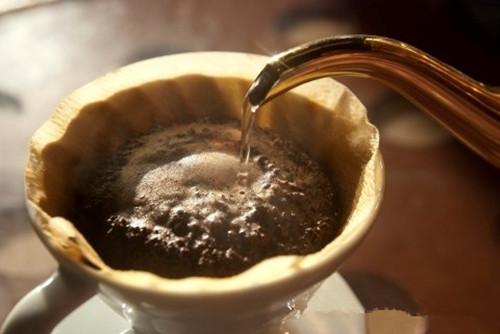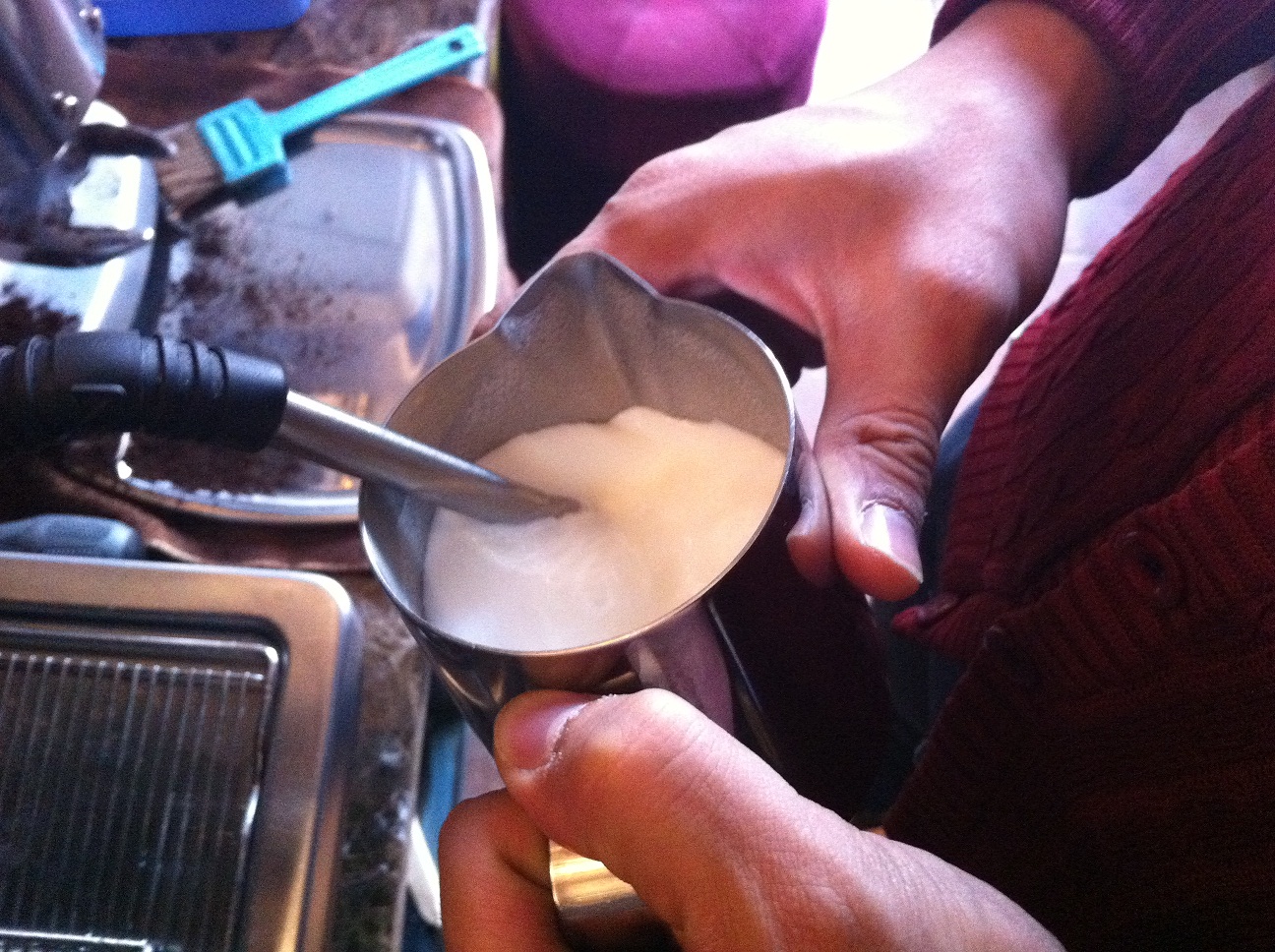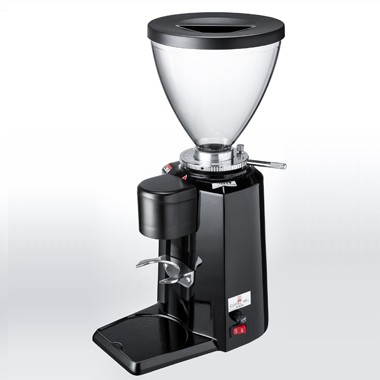Hand-brewed coffee-experience the most primitive and unique flavor of coffee
The coffee extracted by hand method is called hand-brewed coffee ((Hand Drip Coffee). Hand flushing can bring the personality and characteristics of coffee beans to the extreme, so a single coffee bean is often chosen. Hand-made coffee was invented by the French, but it was the Japanese who carried it forward.
Some people think that hand-brewed coffee is the healthiest way to drink coffee, taking into account all the coffee oil and unhealthy ingredients outside the coffee, pure and elegant coffee aroma, let you feel a natural serenity.
The basic utensils needed for hand coffee are as follows: hand pot, hand cup, filter paper, bean grinder, freshly roasted coffee beans.
Hand brewing may be the highest level of coffee brewing. With the support of rich experience, with the simplest tool, a cup of coffee with great personality can be obtained by controlling water temperature, powder quantity and thickness, flushing speed, technique and extraction time.
Example: making hand-brewed coffee with V60 hand cup (for two)
→ 25 grams of coffee powder (depending on your taste preference, you can increase or decrease the amount of coffee powder used)
Degree of grinding → medium fineness
Extraction temperature → 85 degrees
Coffee liquid extract → 280ml
Step 1: origami filter paper. Select the V60 filter paper for two people, fold the filter paper into a cone along the edge of the seam of the filter paper, and put it into the V60 cup.
Step 2: wet the filter paper. Remove the smell of filter paper.
Step 3: grind beans and pour powder. Pour the ground powder into the silk-moistened filter paper, gently pat the filter cup, smooth the powder, and dig a small hole in the center of the powder.
Step 4: warm the cup and warm the pot. Pour a small amount of hot water into the bottom pot, shake a few times, and then pour out. Then put the solid bean powder on the bottom pot.
Step 5: prepare 85 degrees hot water.
Step 6: steaming. Pour water from the center of the powder and circle 2-3 times. Freshly baked coffee powder will expand after absorbing water, protruding upward, emitting a light mellow flavor. At this time, there is basically no water dripping from the filter cup, and it is normal to have 3-5 drops. The purpose of steaming is to let the dry powder absorb water evenly and prepare for secondary water injection.
Step 7: brew. After more than ten seconds, the water is injected stably with a flow thicker than that of steaming. Pay attention to the flow of water not to rush to the filter paper, otherwise the extraction is insufficient. This step will inject water twice until the required liquid is extracted.
Step 8: fill the cup. Before filling the cup, you should warm the cup with water, and then gently shake the hand to make the coffee thick and light. After pouring out the warm cup water, pour the coffee into the cup and you can produce it. Usually the whole process takes 3 minutes.
In order to show the personality characteristics of different coffee beans, the freshness of coffee bean roasting, the professional level and point of view of the store, as well as the drinking preferences of guests in different regions, there will be many differences in the choice of hand-flushing utensils, grinding methods, flushing methods and so on. Fresh baking within 10 days is recommended. Fresh coffee beans are the first condition for making hand-made coffee. Take fried peanuts as an example, the stale ones are not only not crisp or delicious, but also produce substances harmful to health because of the deterioration of the oil. Unfortunately, there are not many coffee shops that can offer fresh baking at present. A large number of coffee shop chains are limited by the scale of management, and the coffee beans are already roasted quite well before January to February. In Japan and South Korea, this kind of freshly baked coffee shop has become quite popular.
Perhaps we often forget that in various dazzling coffee shops, a wide variety of coffee was originally a kind of agricultural product. Just like the tea that Chinese people like to drink. Different varieties, different producing areas, different extraction methods, will also have different taste. If you calm down and savor it carefully, you will always find the one we like. Coffee beans are the second most important raw material in world trade after oil.
Friends who often drink coffee tend to start with instant solution. From Nestl é to G7, and from Starbucks to professional bakeries, you will inevitably want to challenge hand-made coffee in the end. After all, hand-brewed coffee allows us to taste the authentic taste of our favorite drinks, exercise and challenge our own taste buds. It may be hard to imagine that there are 700 to 850 aromatic substances in a small coffee bean locked in the raw bean in the form of a password. But raw coffee beans cannot be detected without roasting these aroma factors, it is just a code. Roasted coffee beans can identify more than 100 fragrances, which can be described as one of the most complex substances.
Factors affecting hand flushing:
First: raw bean factor. Raw beans account for 60% of a good cup of brewed coffee. Baking accounts for 30% and extraction accounts for only 10%. Raw bean factors include the variety of raw beans (Arabica is the best, and the advanced Robosta is fine), the harvesting method of raw beans (whether manual picking is used to ensure the agreed maturity of coffee beans), raw bean treatment (water washing treatment or well-managed drying treatment), and the grade of raw beans (whether they are more advanced raw beans). The freshness of raw beans (is it the new beans harvested that year)
Second: baking degree. Each kind of coffee bean has its own baking degree, and it can't be roasted at will. Only the appropriate baking degree will give play to the characteristics of the bean itself during extraction.
Third: the freshness of baked beans. Fresh beans can give full play to their characteristics. generally speaking, the coffee powder used for hand-brewed coffee is the best before making coffee, so that the flavor of coffee can be preserved to the maximum extent. If it is ground into powder before use, it will speed up its oxidation rate, and when used, it will not be fresh, and the coffee flavor will not be lost to get rich coffee.
Fourth: the degree of grinding. The degree of grinding largely determines the taste of coffee. Generally speaking, the rougher the grinding degree, the stronger the sour taste, and the finer the grinding degree, the stronger the bitter taste.
Fifth: extract water temperature. Too high water temperature will make coffee more bitter, while low water temperature will make coffee sour. Of course, if the coffee is not very fresh, in order to give full play to its flavor, it is better to extract it with relatively high temperature water to avoid the coffee extracted is too thin.
Sixth: the amount of extraction. The amount of coffee extracted also has an effect on the taste of coffee. Under the same amount of powder, the more coffee liquid extracted, the stronger the bitter taste of coffee, and the less coffee liquid extracted, the stronger the sour taste of coffee. Generally speaking, the amount of coffee extracted in a single cup is about 100cc, and two cups of 200cc, which determines how much coffee you want to extract.
Seventh: extraction time. The longer the extraction time, the easier it is to extract the bad flavor components of the coffee, and the short time will also make the essence of coffee extraction incomplete, so it is more important to control the extraction time. In general, it is better to extract a single cup of coffee in about 1 minute and 30 seconds.
The evaluation content of hand-brewed coffee
Number one: aroma. Aromas include dry and wet aromas. Dry aroma refers to the aroma of coffee powder after coffee bean grinding, while wet aroma refers to the aroma of coffee liquid. The good aroma is rich and clear, there is no turbid feeling, sometimes there will be ripe fruit aroma or delicate flower aroma.
Second: acidity. All good coffees are sour, but some coffees are sour and some are less sour, which is the difference between high acidity and low acidity. As long as it's not the unacceptable feeling of acetic acid.
Third: suffering. Coffee is bitter, but the bitterness here is not like that of traditional Chinese medicine. To a large extent, the bitterness here will be sweet and bitter, and it will have a beautiful sweet taste after suffering, which is called Huigan. There is also an obvious and inobvious difference between suffering.
Fourth: Yu Yun. That is, the stay time of the taste of coffee in the mouth after drinking coffee, good coffee will have a long aftertaste.
Fifth: mellowness. It can also be understood as thickness, that is, whether the coffee is thin or thick. Different kinds of coffee have different mellowness. Generally speaking, African coffee is more mellow, while Central and South American coffee is lighter and lighter.
First of all, from the consumer's point of view of hand-made coffee, you get more than just a delicious cup of coffee. In the process of enjoying the barista's hand-brewing coffee, the vision, smell and hearing will be satisfied.
* Vision-watch the barista skillfully turn coffee from beans into a cup of drink. In the painting coffee, watching the sand in the timing hourglass flow down with the water in the barista's hand pot, there will be a sense of the passage of time.
* sense of smell-during the extraction process, the coffee powder emits a strong aroma that the finished coffee does not have. Among many friends who like hand flushing, aroma is even the main reason.
* hearing-while operating, the barista will introduce the details of the whole process and gain a lot of professional knowledge about coffee.
* feeling-- it depends on everyone. If you feel it with your heart, you will always experience more.
A better understanding of hand-brewed coffee, the most primitive and unique flavor of coffee, you can not help but love it.

Important Notice :
前街咖啡 FrontStreet Coffee has moved to new addredd:
FrontStreet Coffee Address: 315,Donghua East Road,GuangZhou
Tel:020 38364473
- Prev

How to make a good foam-an important factor that determines the success or failure of a cup of espresso
The first step is to understand the correct operation flow of the steam system of the coffee machine, understand the purpose of the empty steam pipe before and after foam, and understand the importance of towels and easy cleaning in coffee making. The second step is to learn how to use the sprinkler to touch the milk surface, the location and depth of the selected point. The third step is to recognize the two temperatures. One is the starting and ending temperature of foaming.
- Next

The quality of bean grinder is an important factor in determining the quality of coffee-the difference between manual and electric.
No matter what kind of extraction method we use, what kind of coffee beans and equipment we use to make a cup of coffee, the grinding quality plays a key role from beginning to end. Many beginners pay great attention to how to choose equipment and equipment, pay attention to brewing methods, but often ignore the importance of the impact of bean grinders on the product, but do not realize that a cup of good coffee that can really be called a fine product.
Related
- What is the meaning of lactic acid fermentation with coffee bean treatment?
- How to judge the state of foam by sound?
- How does the latte pull out the unicorn pattern? Come to get for a little trick to improve the flower pull!
- Will flower pulling affect the taste of the latte?
- Do you know the history of coffee?
- The difference between honey treatment and sun washing what is raisin honey treatment?
- What kind of milk can a novice use to make coffee foam to keep the foam longer? The correct method and skills of milking tutorial sharing
- Why do washed coffee beans taste sour? Flavor characteristics of washed Coffee
- Introduction to the skill of how to practice the size and height of water injection around the circle of hand-brewed coffee
- How do beginners practice coffee flower drawing from scratch?

